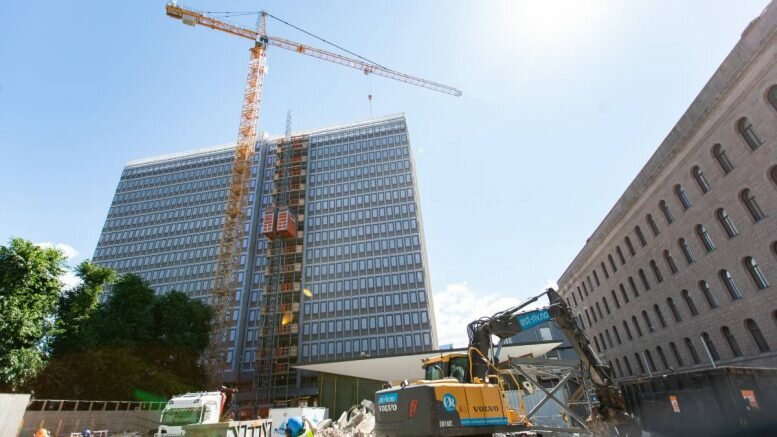The goal of the terrorist bomb attack on July 22 was for Høyblokka (“the highrise”) to collapse, but the concrete building remained standing. Now it has been restored to its original height from 1958.
“We were up there. It was airy there, and you forget a bit that it lacks two floors when you stand on top,” Statsbygg’s communications manager Pål Weiby told news bureau NTB at the huge construction area around the block.
It was originally planned to add four new floors to Høyblokka. However, after it was decided that the prime minister’s office would no longer be at the top of the building, it was decided to peel away the two upper floors that were added in the late 1980s. The two floors have now been removed, and Høyblokka again has its original 15 floors over 48 meters.
Back to 1958
Inside, it is completely empty and looks almost like a disused parking garage. Work is in full swing to return it to its original architectural form from 1958.
“We want to take care of today’s requirements and needs, as well as the needs of the future, at the same time as we take care of the old,” assistant project manager at Statsbygg Carsten Spannagel told news bureau NTB.
The rehabilitation of Høyblokka is a central part of what is called stage 1 in the construction of the new government quarter. This first phase has a cost framework of NOK 20.5 billion. The last two construction stages have not yet been finalized. The costs have not been nailed down, and thus the final price for the entire project has not yet been determined.
Hole in the ground
Two men are cycling along the construction fences by the government quarter, and both are looking and pointing towards the huge cordoned-off area.
“Ten years later, and then there is still just a hole in the ground! Ten years,” one man exclaims to the other. It has been a long process since the bomb went off outside Høyblokka on July 22, 2011. Four buildings suffered significant damage in the explosion, while even more received minor damage. The rough clean-up work alone took just over a year.
“There were lots of important papers that needed to be salvaged, and many of these were full of asbestos. So then people sat on the ground floor and vacuumed every single sheet that was needed,” Weiby said.
A few years later, in 2014, it was decided to rebuild the ruined government quarter rather than build a new one elsewhere in the city.
Construction starts this year
In recent years, three central buildings have been demolished. It was the S-block and R4 that were in the place where the bomb went off. Last year, it was also finally decided that the much-discussed Y-block would be demolished after a year-long process. The demolition started in the early summer of last year, and during the spring of this year, the last remnants were gone.
As recently as last autumn, the Norwegian parliament finally got its thumbs up for the start of construction for the new government quarter, and the work kicked off on January 4 this year.
“We are now in the process of physical work. A lot has been going on, and all the buildings that were to be demolished have been demolished. Things are also done on the ground,” Weiby pointed out.
The prime minister’s office will be moved from Høyblokka to the new neighboring building, D-block. Construction will start this year and will be completed by 2025. As early as 2024, the first bureaucrats will move into parts of the government quarter, which is not expected to be fully completed until 2029.
Polished away
“Anders Behring Breivik’s stated goal with the bomb was that Høyblokka should collapse. But the construction in the building was of such a high quality that the building remained standing,” civil architect and professor Espen Surnevik, who is head of department at the School of Architecture and Design in Oslo, said.
“These are strong buildings that were mainly left standing after the explosion. Only so-called soft building parts gave way, i.e., windows, doors and that kind of thing,” he told NTB.
He says the same also applied to the Y-block, which was designed by the same architect as Høyblokka, Erling Viksjø. The Y-block could have stood for hundreds of years if it had not been demolished, Surnevik believes. At the same time, he emphasizes that one must acknowledge the complex assessments behind all the decisions related to the government quarter.
He looks forward to seeing the finished result of the new quarter. At the same time, he emphasizes how the buildings in the old government quarter were a good mix of very different eras.
“You could actually read the whole of Norway’s history in one area of architecture, layer upon layer. It will probably now be polished away to a greater extent,” he said.
Source: © NTB Scanpix / #Norway Today / #NorwayTodayNews
Do you have a news tip for Norway Today? We want to hear it. Get in touch at info@norwaytoday.no


Be the first to comment on "PHOTO: Høyblokka is back to its original height from 1958"